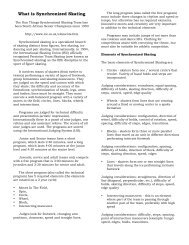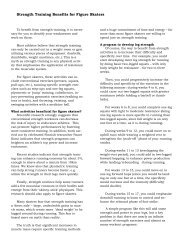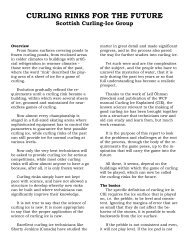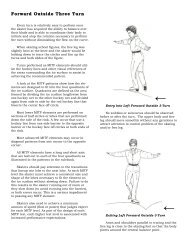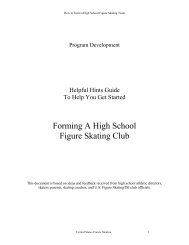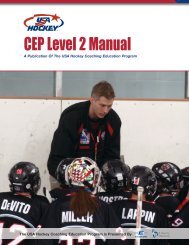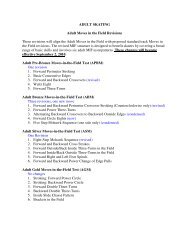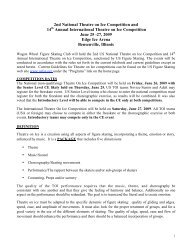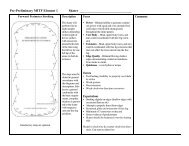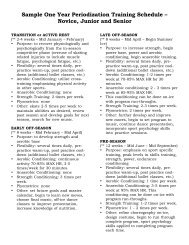A Sample Program for Periodizing the General Athlete - Ice Skating ...
A Sample Program for Periodizing the General Athlete - Ice Skating ...
A Sample Program for Periodizing the General Athlete - Ice Skating ...
You also want an ePaper? Increase the reach of your titles
YUMPU automatically turns print PDFs into web optimized ePapers that Google loves.
A <strong>Sample</strong><br />
<strong>Program</strong> <strong>for</strong><br />
<strong>Periodizing</strong> <strong>the</strong><br />
<strong>General</strong> <strong>Athlete</strong><br />
David Sandler, MS, CSCS<br />
P<br />
eriodization is <strong>the</strong> systematic varying of rep-<br />
etitions, sets, and intensity to peak <strong>the</strong> ath-<br />
letes conditioning at a specific time of <strong>the</strong><br />
year. While athletes completing in a struc-<br />
tured sport will have a predetermined season to periodize <strong>the</strong>ir<br />
program around, <strong>the</strong> recreational athlete does not have this<br />
option. The following article shows how to develop a periodized<br />
program <strong>for</strong> <strong>the</strong> recreational athlete, using <strong>the</strong> calendar year as<br />
<strong>the</strong> season.<br />
To develop skills, <strong>the</strong> skills must be practiced. However, in an<br />
attempt to become as efficient as possible, <strong>the</strong> body will adapt to<br />
<strong>the</strong> specific stimulus, maintaining its homeostasis. This homeostasis<br />
is most often associated with staleness, or more commonly,<br />
plateauing. Fur<strong>the</strong>r, this state often leads to injury or overtraining.<br />
To prevent this, a periodized program needs to be<br />
adapted, modified, and specifically set to meet <strong>the</strong> demands of<br />
your particular sport.<br />
Phases of <strong>the</strong> Periodized<br />
<strong>Program</strong><br />
While traditional periodization follows a pattern of hypertrophy,<br />
strength, power and peaking, it is not necessary <strong>for</strong> all sports to<br />
follow this <strong>for</strong>mat. In fact, in many sports it is unnecessary to<br />
attempt a 1RM.<br />
The hypertrophy phase is a name given to a period within <strong>the</strong><br />
pre-season and usually a period in where <strong>the</strong> athlete returns to<br />
his/her normal level after <strong>the</strong> off-season. The hypertrophy phase<br />
is designed to increase <strong>the</strong> athlete’s muscle mass, preparing <strong>the</strong>m<br />
<strong>for</strong> higher intensity work to follow. Hypertrophy training<br />
involves sets in <strong>the</strong> 8 – 12 repetition range.<br />
The second phase of <strong>the</strong> program, <strong>the</strong> strength phase, is <strong>the</strong> period<br />
that usually best prepares <strong>the</strong> athlete <strong>for</strong> competition. It features<br />
a moderate number of repetitions (5–8), and slightly longer<br />
rest periods (3 – 5 minutes) between each set. This phase also<br />
occurs in <strong>the</strong> pre-season and is marked by its strength increasing<br />
design.<br />
The power phase is a short phase that occurs immediately be<strong>for</strong>e<br />
or during <strong>the</strong> season. It typically features a small number of repetitions<br />
(3 – 5), which are used in more explosive exercises and<br />
movements. Rest between sets is relatively long, sometimes<br />
reaching as much as 7 – 10 minutes.<br />
The peaking phase is <strong>the</strong> period where <strong>the</strong> athlete peaks <strong>for</strong> a<br />
particular event or in <strong>the</strong> case of a team sport, <strong>the</strong> playoffs. In<br />
terms of resistance training it represents <strong>the</strong> “maxing” or testing<br />
of <strong>the</strong> athlete, and generally features 1 – 3 repetitions.<br />
The recovery phase may ei<strong>the</strong>r be a long rest period (days off) or<br />
an active rest period, and normally occurs at <strong>the</strong> end of <strong>the</strong> competitive<br />
season. Many people are concerned about detraining<br />
during this phase. The likelihood of losses during this time are<br />
minimal provided some activity is per<strong>for</strong>med, thus <strong>the</strong> recovery<br />
period allows <strong>for</strong> recovery and rebuilding.<br />
NSCA’s Per<strong>for</strong>mance Training Journal Volume 1 Number 9 | www.nsca-lift.org/per<strong>for</strong>m<br />
21
Table 1*: Phases of <strong>the</strong> Periodized <strong>Program</strong><br />
Sets<br />
Reps<br />
Volume<br />
Intensity<br />
Hypertrophy<br />
2 – 4<br />
8 – 20<br />
High<br />
Low<br />
Strength<br />
2 – 5<br />
4 – 8<br />
High<br />
Med High<br />
Steps in Planning <strong>the</strong> <strong>Program</strong><br />
The first step is determining each of <strong>the</strong> seasons, and setting <strong>the</strong><br />
macrocycle or complete program. The next step is to break<br />
down <strong>the</strong> complete program into smaller mesocycles and microcycles.<br />
Finally, determine <strong>the</strong> phase, or combination of phases,<br />
you will use within each mesocycle. Then figure out <strong>the</strong> actual<br />
exercises <strong>for</strong> weight training and intervals <strong>for</strong> <strong>the</strong> anaerobic/aerobic<br />
metabolic conditioning.<br />
Each periodized program should have a goal. It should be specific<br />
to <strong>the</strong> sport and/or <strong>the</strong> athlete. For periodization to work,<br />
it must be followed strictly.<br />
<strong>Program</strong>ming <strong>the</strong> Complete<br />
<strong>Athlete</strong><br />
The essence of any good program is <strong>the</strong> planning and preparation<br />
that goes into it. A thorough needs analysis of <strong>the</strong> sport<br />
requirements and <strong>the</strong> athlete’s conditioning level is necessary to<br />
design <strong>the</strong> ideal program. There are however, certain rules and<br />
exercises that can be generally applied across many sports. The<br />
following periodization program is geared to <strong>the</strong> recreational<br />
athlete, or dedicated fitness enthusiast. The program is progressive<br />
and attacks <strong>the</strong> important elements of fitness and athleticism.<br />
Developing <strong>the</strong> <strong>Program</strong><br />
To develop a sound training program, it is necessary to examine<br />
<strong>the</strong> sport requirements and/or client goals. We will use a needs<br />
analysis approach and develop a program using a hypo<strong>the</strong>tical<br />
athlete. We will assume <strong>the</strong> client is able to per<strong>for</strong>m <strong>the</strong> exercises<br />
selected and has been cleared to exercise. It will also be<br />
assumed that <strong>the</strong> athlete is looking to improve overall strength<br />
and energy.<br />
Power<br />
*This table is adapted from Fleck and Kraemer, Designing Resistance Training <strong>Program</strong>s.<br />
Depending on time, it may be necessary to vary workouts from<br />
2 to 4 times per week. Since we will try to develop strength,<br />
power, balance, speed, and agility, we will favor doing a two-day<br />
or three-day workout. If time permits, <strong>the</strong> two-day workout can<br />
be doubled, making four work days during a week. To develop<br />
overall skills, we will stick to gross movements consisting of multiple<br />
joint exercises in <strong>the</strong> weight room, and take it to <strong>the</strong> field<br />
<strong>for</strong> <strong>the</strong> conditioning and o<strong>the</strong>r components.<br />
The first thing to do is to determine <strong>the</strong> relative energy requirements<br />
of <strong>the</strong> particular sport <strong>the</strong> athlete is interested in. In <strong>the</strong><br />
case of many recreational athletes, this will vary quite a bit, as<br />
most are involved in several activities. The second component of<br />
our training prescription is deciding on <strong>the</strong> appropriate number<br />
of repetitions and sets <strong>for</strong> both resistance training exercises, and<br />
balance, agility, and power related exercises. Again, we need to<br />
be specific in terms of applying suitable volume based on sport<br />
need. For <strong>the</strong> general fitness enthusiast, repetition range should<br />
be between 5 and 12.<br />
Keeping in mind that time is always an issue, we recommend<br />
doing a complete body workout preceded, or followed by interval<br />
training, plyometrics, agilities and rotational training. This<br />
will depend on <strong>the</strong> time of year and <strong>the</strong> client’s needs.<br />
Interval Training<br />
Interval training is a very good method of training because it<br />
allows maximal ef<strong>for</strong>t <strong>for</strong> repeated trials. This benefit allows<br />
more time at <strong>the</strong> maximal level because <strong>the</strong> rest interval will<br />
allow recovery. Ra<strong>the</strong>r than per<strong>for</strong>ming one continuous session<br />
or short session, multiple sessions can be per<strong>for</strong>med on <strong>the</strong> same<br />
training day. Thus, two, three, four, or more times <strong>the</strong> amount<br />
of work can be per<strong>for</strong>med. However, it should be noted that <strong>for</strong><br />
best results, <strong>the</strong> athlete must give 100% ef<strong>for</strong>t both mentally and<br />
physically <strong>for</strong> <strong>the</strong> prescribed times in each interval.<br />
NSCA’s Per<strong>for</strong>mance Training Journal Volume 1 Number 9 | www.nsca-lift.org/per<strong>for</strong>m<br />
22<br />
3 – 5<br />
3 – 5<br />
Low<br />
High<br />
Peaking<br />
1 – 3<br />
1 – 3<br />
Low<br />
Very High
Table 2: Combo Routines<br />
Day 1<br />
Squat or Leg Press<br />
Bench Press<br />
Pull-up<br />
Step-up<br />
Incline Dumbbell Press<br />
Bent Over/Machine Row<br />
Romanian Deadlift<br />
Rotator-Cuff Circuit<br />
Day 2<br />
Lunge<br />
Dumbbell Press<br />
Dumbbell Row<br />
Leg Extension<br />
Dumbbell Press<br />
Leg Curl<br />
Biceps<br />
Triceps<br />
Day 3<br />
Bench Press<br />
3 Position Pulls*<br />
NSCA’s Per<strong>for</strong>mance Training Journal Volume 1 Number 9 | www.nsca-lift.org/per<strong>for</strong>m<br />
23<br />
Squat<br />
Leg Curl<br />
Calf Raise<br />
Superset Bicep Curl and<br />
Tricep Extension
Table 3: Upper-Lower Routines<br />
Upper 1<br />
Bench Press<br />
Incline Press<br />
Military Press (standing)<br />
Triceps Extension<br />
Bent-Over Row<br />
Lat Pull-down<br />
Shrugs<br />
Biceps Curls<br />
Table 4: Split Routines<br />
Push<br />
Bench Press<br />
Squat<br />
Military Press<br />
Step Up<br />
Triceps Extension<br />
Calf Raise<br />
Back Extension<br />
Upper 2<br />
Pull-Up<br />
Dumbbell Bench Press<br />
Dumbbell Row<br />
Incline Dumbbell Press<br />
Dumbbell Shrug<br />
Dumbbell Triceps<br />
Extension<br />
Dumbbell Curls<br />
Pull<br />
Cable/Pulley Row<br />
Deadlift<br />
Chin-Up<br />
Leg Curl<br />
High Pull<br />
Biceps Curl<br />
Crunch<br />
Lower 1<br />
Step-Up<br />
Push/Pull Combo<br />
NSCA’s Per<strong>for</strong>mance Training Journal Volume 1 Number 9 | www.nsca-lift.org/per<strong>for</strong>m<br />
24<br />
Lunge<br />
Squat<br />
Leg Curl<br />
Romanian Deadlift<br />
Plantar Flexion<br />
Dorsi-flexion<br />
Lunge<br />
Incline Dumbbell Press<br />
Step Up<br />
Upright Row<br />
Russian Deadlift<br />
Biceps<br />
Triceps<br />
Crunch w/ Twist
Varying Routines<br />
Periodization is <strong>the</strong> act of changing routines to meet needs.<br />
Identifying those needs allow us to build a good program. It is<br />
our suggestion that no cycle should last more <strong>the</strong>n 4 to 5 weeks<br />
and that <strong>the</strong> end of each cycle include a “tapering” or “detraining”<br />
week to prevent staleness. Overall, <strong>the</strong> volume and intensity<br />
should reflect <strong>the</strong> time of year and clients specific goals, with<br />
lower volume and intensity work occurring during busy or active<br />
times and high-volume work when more time and ef<strong>for</strong>t can be<br />
af<strong>for</strong>ded towards <strong>the</strong> workouts.<br />
Summary<br />
Periodization is a necessity, especially when looking at <strong>the</strong> true<br />
metabolic and biomechanical demands of <strong>the</strong> sport. A key component<br />
<strong>for</strong> developing good programs is <strong>the</strong> ability and <strong>the</strong><br />
knowledge to <strong>for</strong>-see problems and have a method to modify<br />
<strong>the</strong>m. When using periodization, <strong>the</strong> percentage-based method<br />
should only be used with sports requiring “one-time” peaking<br />
such as lifting or certain track and field events. However, it does<br />
not mean that it is wrong to use <strong>the</strong> %1RM method <strong>for</strong> your<br />
sport. In most cases however, it is suitable to use <strong>the</strong> “best set”<br />
as <strong>the</strong> basis <strong>for</strong> <strong>the</strong> program.<br />
References<br />
Fleck S, Kraemer W. 1997. Designing resistance training programs.<br />
Champaign, IL: Human Kinetics.<br />
About <strong>the</strong> Author<br />
David Sandler, MS, CSCS David is a professor of Exercise<br />
Physiology and Strength & Conditioning at Florida International<br />
University, one of <strong>the</strong> first schools to receive recognition from <strong>the</strong><br />
NSCA. He developed and directs <strong>the</strong> Strength and Conditioning<br />
Curriculum. David, a <strong>for</strong>mer strength and conditioning coach with<br />
<strong>the</strong> University of Miami, is completing his doctoral work in <strong>the</strong>ir<br />
Exercise and Sports Science Department. He is a frequent contributor<br />
to several fitness magazines and has presented at numerous<br />
national conferences and conventions throughout North America.<br />
David is a founding partner in StrengthPro, a Miami based strength<br />
consulting firm.<br />
NSCA’s Per<strong>for</strong>mance Training Journal Volume 1 Number 9 | www.nsca-lift.org/per<strong>for</strong>m<br />
25



